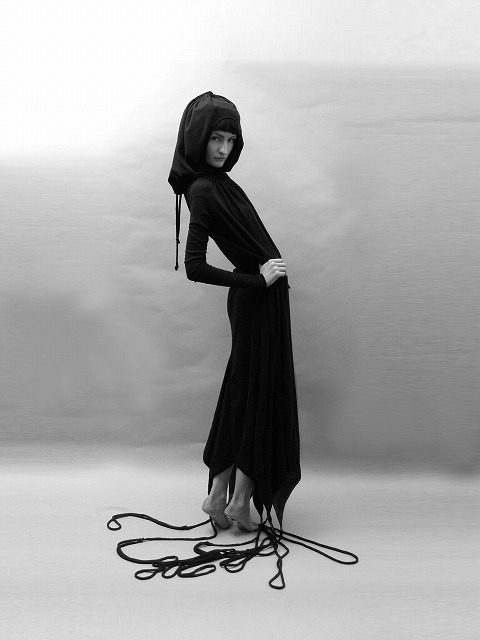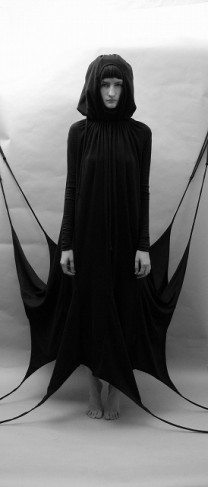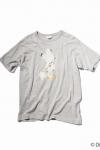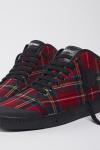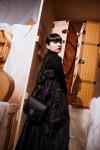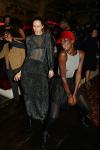“I have always used art as a form of expression, but once I learned how to sew, I liked that I could make art that had the addtional benefit of being functional and wearable.”
-Please tell me a bit about yourself
I am a London-based fashion designer who is originally from California. I moved to London in order to promote my designs to the international fashion market. Utilizing my learning experiences gained at Central St. Martins and Rhode Island School of Design and in the studios of Alexander McQueen and Zandra Rhodes, I decided to launch her own company in 2008. My monochromatic Black Label collection was created to fulfill her need for expression through sculptural and textural manipulations of fabric.
I am now designing my fourth season and I have received glowing reviews from the press (including i-D Magazine) as well as support from my mentor and friend, British fashion designer Sir Paul Smith. As well as creating a new collection and accompanying performance two times a year, I have also been busy working on a special project with cult drone musician Stephen O’Malley of Sunn0))) fame. Following the huge success of our collaborative SS10 fashion film we have now joined forces again to design the robes for the latest Sunn0))) tour in support of the band’s new album, Monoliths and Dimensions.
“Alexandra Groover is a young designer whose jersey collection is both creative and wearable.” Sir Paul Smith, i-D Magazine, Lovers of Life issue no.305.
-How did you get into fashion? What made you want to become a designer?
My mother sent me to my first sewing class when I was 11 years old, and I have been making clothes ever since then.
-Your collections are very structural in their design. What are the sources of inspiration in your work?
My inspiration always starts with nature. I am most interested in the architectural structures created by nature such as shells and the body structures of other plants and animals. I like to interpret these in my clothes.
-You have a Black and Gray label on your web site, how do you separate the two labels?
I originally had two separate labels because I thought I needed to keep the formal and casual separate. But now I have decided that they work better together so have combined the two into one full range.
-Why do you prefer to design only in black?
When designing clothing, I like to focus on texture, silhouette, and subtle details. I find that when colour is added, it acts as a distraction to these things. Because I decided to work in only one colour, I chose black for a number of reasons. It is my favorite, as well as being a classic non-colour that looks great on everyone.
-Are you interested in japanese fashion and markets in Japan? If so why ?
I am very interested in the Japanese market. I have never been there before, but there has been a lot of interest in my clothing and I would like to visit and hopefully find some boutiques that would like to sell my clothing.
-Would you like to open your own shop in Japan?Do you have any stock lists in Japan already?
Eventually, when my business has grown to a substantial size, it would be very nice to have a shop in Japan. My business is still very young, however, so I think it would be best to start out by selling at some established stores in Japan. I do not have any stockists yet, but it is my plan to find one for my new SS-11 collection.
-Are there any designers or a particular person that has a strong influence of your work?
As a child, the architectural designs of Yohji Yamamoto and Issey Miyake showed me that fashion can be approached as a fine art, which really inspired me. If it wasn’t for them, I probably wouldn’t have gone to school to study fashion design. My parents were also a very big influence in my decision to become a designer, as my late father was a painter and my mother is a jewellery designer.
-Did you get any influence to your designer life from Alexander McQueen?
Lee McQueen was an extremely driven, passionate, creative person who pushed himself until he got exactly what he wanted, even if it seemed impossible to achieve. This is something I learned from him and I respect and value it very much in my own work. It was a privilege to have had the opportunity to experience the design process of one of the most important designers of our generation.
-What are the most important factors when you approach your work?
I like to start by taking my initial inspiration and experimenting with that idea in relationship to the fabric. I get the best results when I spend a lot of time playing with the fabric and creating little sculptures with it.
-How do you describe the characteristic of your style which makes it difference from others?
My clothing can be very sculptural and avant garde at times, but it is always wearable. I like to make interesting things, but it is nice to also be able to wear the garment as well. A lot of designers like to make things that are interesting to look at but aren’t actually functional as a garment. I like the challenge of trying to make my clothing as interesting as possible, whilst still being wearable.
-Why do you think about wearable and function is important for your design?
I admire those who treat fashion as an art form and can appreciate unwearable garments that are designed for these purposes, but I personally enjoy the challenge of making something that has both aesthetic integrity as well as wearability.
-Do you view fashion design as a means of expressing yourself?
I have always used art as a form of expression, but once I learned how to sew, I liked that I could make art that had the addtional benefit of being functional and wearable. Fashion is a particularly special way of expressing oneself because it can be worn on the body. It can show many things about a person, which is another theme that I enjoy exploring in my work.
-What do you want to make expression in your design? Are there any messages to someone in your design?
I feel more like a fine artist myself. My creative adventures tend to be a combination of experimentation with materials and autobiography. I am always drawn to the architecture of nature. I simply enjoy playing with fabric to create naturally inspired pieces and I find additional pleasure in being able to translate my experiments into something useful that other people can relate to and enjoy.
-What is your vision for the future?
I have so many visions for the future. In the distant future, I am very excited about new technology and integrating it into my designs. In the near future, I would like to have more stockists internationally so that I can continue to build my business and introduce myself to new countries and cities.

